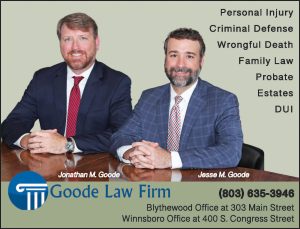What Else We Learned from the County’s Sept. 22 Presentation
WINNSBORO – Parker Poe bond consultant Ray Jones was the bond council who worked with the Fairfield County Council and helped draft the legal documents for the $24 million bond issuance in March 2013, and for the smaller general obligation (GO) bonds issued in February and August of this year.
After The Voice first revealed last March that the County was issuing GO bonds to make installment purchase payments on the $24 million bonds, on Sept. 22 Jones, at the County’s request, explained the bonds to the public during a County Council meeting.
During his presentation, Jones identified meetings in which he claimed the issuance and financing of the $24 million bonds were fully and publically explained. But digital recordings of those meetings obtained by The Voice from the County through Freedom of Information Act (FOIA) requests do not bear out those claims.
Not only were the bonds not fully and publicly explained, but the public was fed misinformation by then County Administrator Phil Hinely and some Council members that may have impeded the public from taking advantage of a 60-day window in which they could have forced a referendum (vote) on Ordinance 614 which provided for the future issuance of an unlimited number of GO bonds. [Note: SC Statute 4-9-1220 provides that “Within sixty days after the enactment by the council of any ordinance authorizing the issuance of bonds, notes or other evidence of debt the repayment of which requires a pledge of the full faith and credit of the county…a petition signed by qualified electors of the county equal in number to at least fifteen percent of the qualified electors of the county…may be filed with the clerk of the county council requesting that any such ordinance be repealed.]
Instead of explaining to the public on April 15, 2013, that Council had on that date passed Ordinance 614 which set the GO bonds in motion (and which could have been repealed through petition within 60 days), it was reported in the newspaper that both Hinely and Council members said Council had acted at that meeting (April 15, 2013) to issue the $24 million bonds. But the $24 million (IPRBs) had actually been issued on April 7, and not by the County but by the Fairfield Facilities Corporation (FFC), a non-profit corporation created by the County with a resolution passed two weeks earlier, on March 25, 2013.
At last week’s meeting, Jones explained to the public for the first time much of the plan behind the bond issuances, how the bonds work, what role the FFC played in the bond financing plan and what options are available to the County for paying off the bondholders.
Jones said the first goal of issuing the $24 million IPRBs was to finance certain projects such as its industrial parks, other facilities in the county and recreation facilities. He said Council wanted to “keep the millage steady so as to protect the County’s debt capacity.” To that end, in 2013, both Hinely and Council Chairman David Ferguson insisted that the $24 million bonds would not increase the County’s ad valorem tax rates, but stopped short of explaining that, instead of letting the County’s 10.4 debt service millage decrease to zero in 2019 when the County’s 2009 $6.5 million bond is paid off, Council made provisions to issue semi-annual GO bonds that would keep the debt service up at a 10.4 millage rate for up to 22 years with decreasing millage for another five years.
That level of millage would bring in approximately $1.3 million in property taxes per year, or about $35 million total over the life of the $24 million bonds. A chart provided by the County through a FOIA request, and which was printed in the Sept. 19 issue of The Voice, graphs this debt service tax revenue.
In his presentation, Jones pointed out that that millage revenue produced by issuing a number of new GO bonds (up to the County’s full debt capacity under the law without voter approval), along with some cash from the general fund, would be enough to make all of the County’s installment payments (totaling approximately $43 million) to the FFC over the life of the $24 million bonds. Jones said the County could make all of its payments to the FFC without tapping any of the revenue from the V.C. Summers Nuclear Plant.
What are IPRBs?
Because the County did not have a stream of revenue (toll road, water company, etc.) it could not issue traditional revenue bonds to pay for its desired projects. General obligation bonds require voter approval for amounts over the County’s bonded debt limit, which is about $4.5 million. So, to borrow $24 million, the County turned to what many lawmakers call a legal but unorthodox installment plan of finance. Jones explained the four elements that made this plan of finance work for Fairfield County.
A nonprofit entity (the Fairfield Facilities Corporation) was created by Council on March 25, 2013, to issue debt on behalf of Fairfield County to finance and construct capital projects. The FFC leases those projects from the County while it improves them over the life of the bond.
The County then acquires from the FFC incremental interests in the projects over time through installment purchase payments, which are in the same amount as the payments the FFC makes to pay off the $24 million IPRBs.
As provided in this kind of financing, the County may use any funds available to make the installment payments (including GO bonds). Traditional revenue bonds can not be paid for with general obligation debt.
The FFC pledges the installment payments it receives from the County as security for the debt (bonds) issued to finance the projects.
When the County has made all of its installment purchase payments, the projects once again become assets of the County.
What Does Ordinance No. 614 Say?
• It provides for the County to issue GO bonds to make the installment purchase payments to the FFC and those payments also serve to purchase (buy back), incrementally, portions of the projects during the life of the $24 million bonds.
• It identifies the projects the County wanted improved/purchased/constructed.
• It allows the County to use a nonprofit corporation (the FFC) to assist with the construction and financing of the projects.
• It authorizes the County to purchase the projects back from the FFC.
• It secures revenue received from the nuclear plant for the purpose of funding infrastructure in the County, including the projects.
Jones insisted that the IPRBs are a sound and legal financing structure, pointing out that the Internal Revenue Service recognizes the nonprofit (FFC) as a valid corporation, worthy of exemption from federal taxation; that national bond rating agencies have consistently assigned some of their highest ratings to this method of finance and that the S.C. Supreme Court upheld the structure and it has been utilized by at least seven other counties, including Lancaster and Chester.
He did not mention, however, that IPRBs have been in the crosshairs of the General Assembly since at least 2006 when the Greenville School District ran up $1 billion in debt by financing school facilities in this manner. The General Assembly put an end to the practice for school districts by tightening up loopholes in the law that allowed this kind of high risk financing for them. State Rep. F. Gregory Delleney Jr. (R-43), Chairman of the House Judiciary Committee, sponsored House Bill 3105 in January 2013 to end IPRB financing, which he calls a rouse. He says the nonprofit corporation is a shell. “The people should be able to vote on a bond referendum of that magnitude,” Delleney said.
Next, a look at why the County issued a GO bond on Aug. 7 that was larger than needed to make its installment payment.












Why is Fairfield County still associated with this bond attorney in ? Seems like he covered up the facts so citizens wouldn’t understand the details. Was everyone on council aware of what they were approving? Asleep at the wheel?